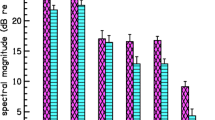Abstract
Experiment 1 elicited the P1, N1, P2, and N2 components of the long latency auditory evoked potential (AEP) using a 1000 Hz tone presented at 30, 50, or 70 dB SPL and 1-, 3-, or 5- second inter-stimulus intervals to assess the relative effects of the combination of these variables on component amplitude and latency. Four blocks of 16 tone presentations each were recorded from each subject to determine if changes in the AEP would occur because of short-term habituation. Both stimulus factors interacted significantly in a systematic fashion for the amplitude measures, with increases in latency also associated with increases in intensity and inter-stimulus interval. Only minor changes across the four trial blocks for either the amplitude or latency measures were observed over the various stimulus presentation conditions. Experiment 2 employed the same tone stimulus presented at 50 dB SPL and a 3-second inter-stimulus interval. Eight blocks of 64 trials were recorded from each subject on each day for four days to investigate long-term habituation effects. No substantial changes in any of the component amplitudes or latencies were obtained across the 32 trial blocks. It was concluded that intensity and inter-stimulus interval interact to determine AEP amplitude as well as latency values and that the constituent components do not change appreciably with repeated stimulus presentations, even after several days.
Similar content being viewed by others
References
Bothe, G. B., Zahn, D. A., and Elfner, L. F. (1974) The effects of physical stimulus complexity on the auditory-evoked response.Biological Psychology, 1, 261–275.
Bourbon, T. W., Will, K. W., Gary, H. E., and Papanicolaou, A. C. (1987) Habituation of auditory event-related potentials: a comparison of self-initiated and automated stimulus trains.Electroencephalography and Clinical Neurophysiology, 66, 160–166.
Butler, R. A. (1972) The auditory evoked response to stimuli producing periodocity pitch.Psychophysiology, 9, 233–237.
Davis, H., and Zerlin, S. (1966) Acoustic relations of the human vertex potentials.Journal of the Acoustical Society of America, 39, 109–116.
Elton, M., Schandry, R., and Sparrer, B. (1983) A comparative investigation of ERP components and the SCR in a habituation and dishabituation paradigm.International Journal of Neuroscience, 22, 55–62.
Fruhstorfer, H. (1971) Habituation and dishabituation of the human vertex response.Electroencephalography and Clinical Neurophysiology, 30, 306–312.
Fruhstorfer, H., Soveri, P., and Jarvilehto, T. (1970) Short-term habituation of the auditory evoked response in man.Electroencephalography and Clinical Neurophysiology, 28, 153–161.
Loveless, N. (1983) The orienting response and evoked potentials in man. In D. Siddle (Ed.),Orienting and Habituation: Perspectives on Human Research. New York: John Wiley & Sons, 71–108.
Nelson, D. A., and Lassman, F. M. (1973) Combined effects of recovery period and stimulus intensity on the human auditory evoked vertex response.Journal of Speech and Hearing Research, 16, 297–308.
Ohman, A., and Lader, M. (1977) Short-term changes of the human auditory evoked potentials during repetitive stimulation. In J. E. Desmedt (Ed.),Auditory Evoked Potentials in Man. Psychopharmacology Correlates of EPs. Progress in Clinical Neurophysiology, Vol. 2. Karger, Basel, 93–118.
Picton, T., Goodman, W., and Bryce, D. (1970) Amplitude of evoked responses to tones of high intensity.Acta Otolaryngologica, 70, 77–82.
Picton, T., Woods, D., Baribeau-Braun, J., and Healey T. (1977) Evoked potential auditometry.Journal of Otolaryngology, 6, 90–119.
Polich, J. (1986) P300 development from auditory stimuli.Psychophysiology, 23, 590–597.
Polich, J., and Starr A. (1983) Middle- late-, and long-latency auditory evoked potentials. In E. J. Moore (Ed.),Auditory Brain-Stem Evoked Responses. New York, Grune & Stratton, 345–361.
Prosser, S., Arslan, E., and Michelini, S. (1981) Habituation and rate effect in the auditory cortical potentials evoked by trains of stimuli.Archives of Otolaryngology, 233, 179–187.
Roeser, R. J., and Price, L. L. (1969) Effects of habituation on the auditory evoked response.Journal of Auditory Research, 9, 306–313.
Roemer, R. A., Teyler, T. J., and Shagass, C. (1984) Do human evoked potentials habituate? In H. Pecke and L. Petrinovich (Eds.),Habituation, Sensitization, and Behavior. New York, Academic Press, 325–346.
Roth, W. T., and Kopell, B. S. (1969) The auditory evoked response to repeated stimuli during a vigilance task.Psychophysiology, 6, 301–309.
Rothman, H. H., Davis, H., and Hay, I. S. (1970) Slow evoked cortical potentials and temporal features of stimulation.Electroencephalography and Clinical Neurophysiology, 29, 225–232.
Rust, J. (1977) Habituation and the orienting response in the auditory cortical evoked potential.Psychophysiology, 14, 123–126.
Salamy, A., and McKean, C. (1977) Habituation and dishabituation of cortical and brainstem evoked potentials.International Journal of Neuroscience, 7, 175–182.
Weber, B. A. (1970) Habituation and dishabituation of the averaged auditory evoked response.Journal of Speech and Hearing Research, 13, 387–394.
Westenberg, I. S., and Weinberger, N. M. (1976) Evoked potential decrements in auditory cortex. II. Critical test for habituation.Electroencephalography and Clinical Neurophysiology, 40, 356–369.
Woods, D. L., and Elmasian, R. (1986) The habituation of event-related potentials to speech sounds and tones.Electroencephalography and Clinical Neurophysiology, 65, 447–459.
Author information
Authors and Affiliations
Additional information
The research reported here was supported by the J. M. McDonald Foundation and is publication number 4797BCR from the Research Institute of Scripps Clinic.
Rights and permissions
About this article
Cite this article
Polich, J., Aung, M. & Dalessio, D.J. Long latency auditory evoked potentials. Pav. J. Biol. Sci. 23, 35–40 (1988). https://doi.org/10.1007/BF02910543
Issue Date:
DOI: https://doi.org/10.1007/BF02910543




